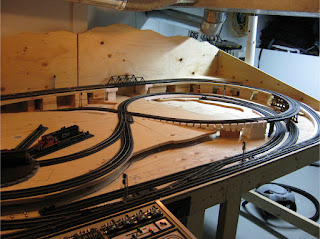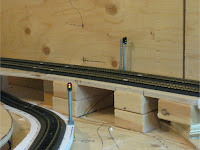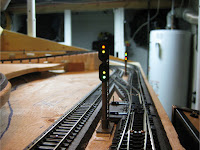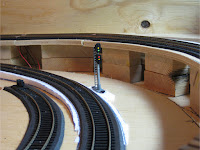My trackside signals are finally complete! When I purchased the little trackside signal face plates and matching LED lights off eBay for about $8.00 last year, I thought I was being really thrifty, which I was, however I then realized that I was now faced with the responsibility of having to make the light standards to hold these signals. Wiring was not an issue as I had incorporated these into my main wiring system, but I now had to find a way to make them look at least somewhat realistic on my layout.



To build the light standards, I went to my local hobby shop and visited the Evergreen Models styrene plastic display. Evergreen makes bulk styrene strips in almost every shape and size imaginable, which is great for these types of projects. I used 7/16” tubing for the mast, which is a little larger than most prototypical-sized masts, but this is the smallest size that would allow me to run the 8 wires through for the dual signals. I then cut notches in the tops of each mast to allow the signals to fit into them.


I then used slightly larger tubing that allowed the 3/16” tubing to fit snugly inside for the base support, as well as around the base of each signal to act as a support. The mast and support where then glued to a 1/16” base. I glued small rectangular pieces of thin styrene on the sides of each signal. This created a smooth transition from the signal to the mast. A second, smaller piece of styrene was then glued to that, simulating a maintenance door. I use poly-filler to fill in any gaps, and to smooth out any really rough edges.


The maintenance ladders were all hand made using .04" styrene strips. I carefully cut every rung to the exact size I needed, then carefully glued them to one of the side supports. I did this on a flat surface to ensure the rungs were all aligned with the support and were all level and square. Once dry, I glued on the other support. Once dry, I glued them directly to the signal units.






0 (mga) komento:
Mag-post ng isang Komento